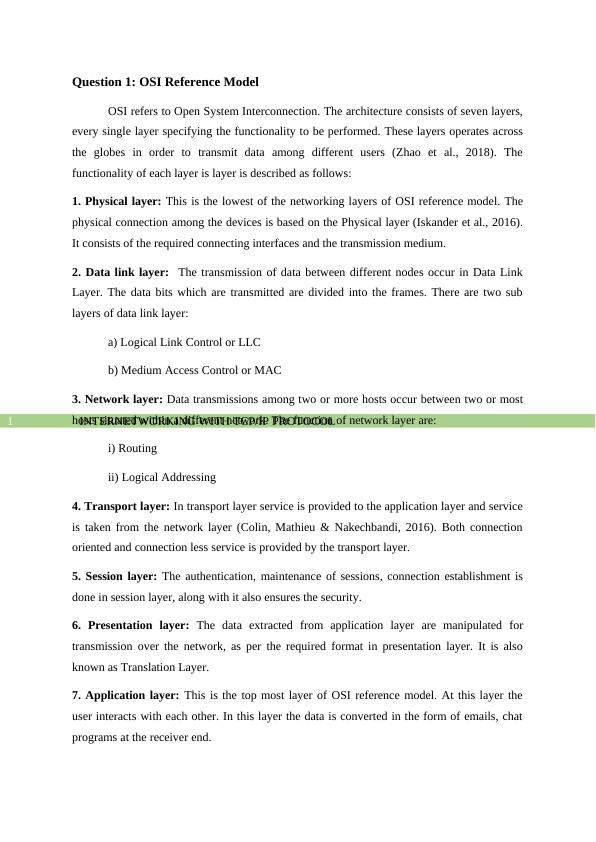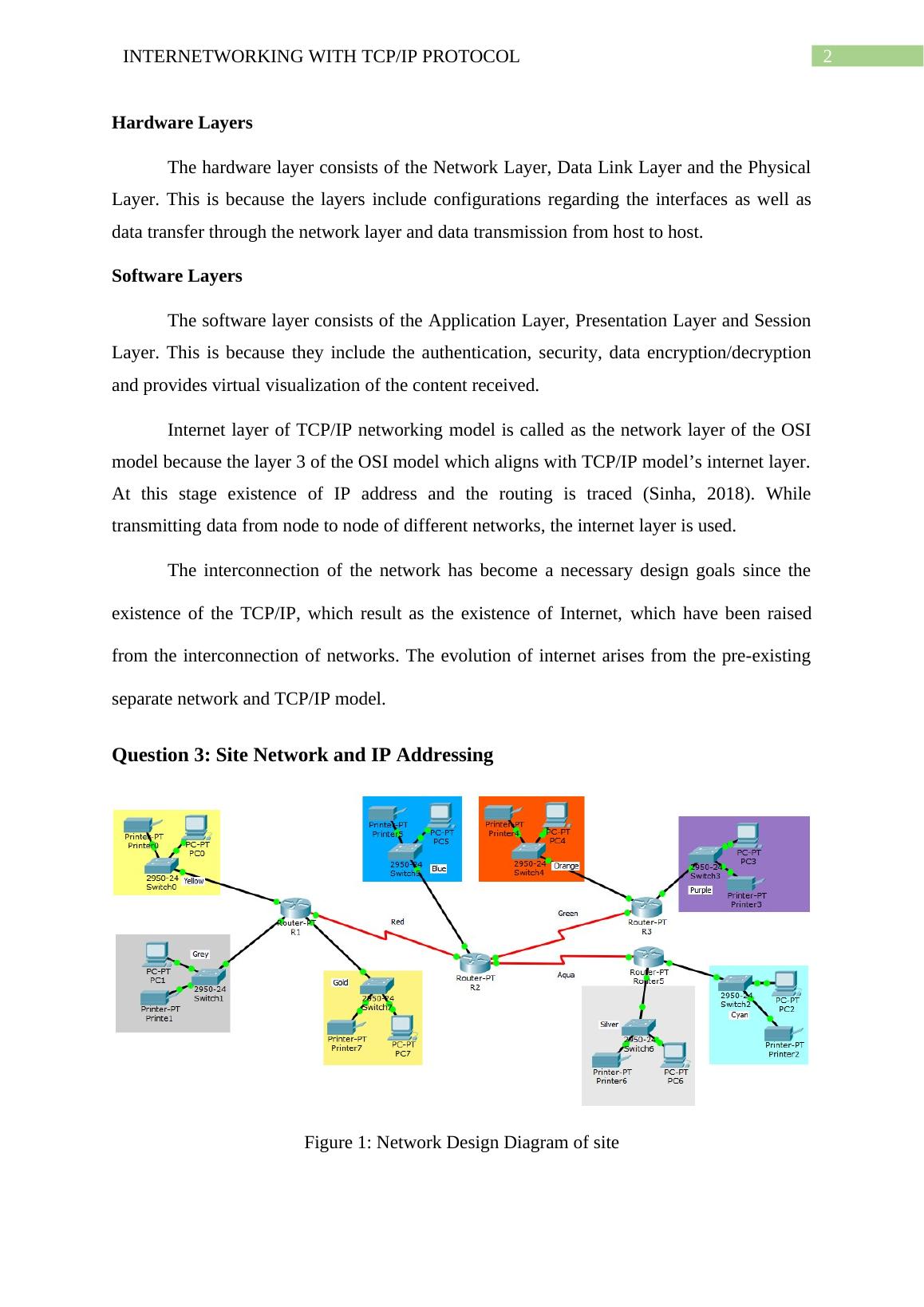Internetworking with TCP/IP Protocol Socket
Added on 2022-09-15
8 Pages1201 Words12 Views
Running head: INTERNETWORKING WITH TCP/IP PROTOCOL
Internetworking with TCP/IP Protocol
Name of the Student
Name of the University
Author Note
Internetworking with TCP/IP Protocol
Name of the Student
Name of the University
Author Note

INTERNETWORKING WITH TCP/IP PROTOCOL1
Question 1: OSI Reference Model
OSI refers to Open System Interconnection. The architecture consists of seven layers,
every single layer specifying the functionality to be performed. These layers operates across
the globes in order to transmit data among different users (Zhao et al., 2018). The
functionality of each layer is layer is described as follows:
1. Physical layer: This is the lowest of the networking layers of OSI reference model. The
physical connection among the devices is based on the Physical layer (Iskander et al., 2016).
It consists of the required connecting interfaces and the transmission medium.
2. Data link layer: The transmission of data between different nodes occur in Data Link
Layer. The data bits which are transmitted are divided into the frames. There are two sub
layers of data link layer:
a) Logical Link Control or LLC
b) Medium Access Control or MAC
3. Network layer: Data transmissions among two or more hosts occur between two or most
hosts situated within a different network. The function of network layer are:
i) Routing
ii) Logical Addressing
4. Transport layer: In transport layer service is provided to the application layer and service
is taken from the network layer (Colin, Mathieu & Nakechbandi, 2016). Both connection
oriented and connection less service is provided by the transport layer.
5. Session layer: The authentication, maintenance of sessions, connection establishment is
done in session layer, along with it also ensures the security.
6. Presentation layer: The data extracted from application layer are manipulated for
transmission over the network, as per the required format in presentation layer. It is also
known as Translation Layer.
7. Application layer: This is the top most layer of OSI reference model. At this layer the
user interacts with each other. In this layer the data is converted in the form of emails, chat
programs at the receiver end.
Question 1: OSI Reference Model
OSI refers to Open System Interconnection. The architecture consists of seven layers,
every single layer specifying the functionality to be performed. These layers operates across
the globes in order to transmit data among different users (Zhao et al., 2018). The
functionality of each layer is layer is described as follows:
1. Physical layer: This is the lowest of the networking layers of OSI reference model. The
physical connection among the devices is based on the Physical layer (Iskander et al., 2016).
It consists of the required connecting interfaces and the transmission medium.
2. Data link layer: The transmission of data between different nodes occur in Data Link
Layer. The data bits which are transmitted are divided into the frames. There are two sub
layers of data link layer:
a) Logical Link Control or LLC
b) Medium Access Control or MAC
3. Network layer: Data transmissions among two or more hosts occur between two or most
hosts situated within a different network. The function of network layer are:
i) Routing
ii) Logical Addressing
4. Transport layer: In transport layer service is provided to the application layer and service
is taken from the network layer (Colin, Mathieu & Nakechbandi, 2016). Both connection
oriented and connection less service is provided by the transport layer.
5. Session layer: The authentication, maintenance of sessions, connection establishment is
done in session layer, along with it also ensures the security.
6. Presentation layer: The data extracted from application layer are manipulated for
transmission over the network, as per the required format in presentation layer. It is also
known as Translation Layer.
7. Application layer: This is the top most layer of OSI reference model. At this layer the
user interacts with each other. In this layer the data is converted in the form of emails, chat
programs at the receiver end.

INTERNETWORKING WITH TCP/IP PROTOCOL2
Hardware Layers
The hardware layer consists of the Network Layer, Data Link Layer and the Physical
Layer. This is because the layers include configurations regarding the interfaces as well as
data transfer through the network layer and data transmission from host to host.
Software Layers
The software layer consists of the Application Layer, Presentation Layer and Session
Layer. This is because they include the authentication, security, data encryption/decryption
and provides virtual visualization of the content received.
Internet layer of TCP/IP networking model is called as the network layer of the OSI
model because the layer 3 of the OSI model which aligns with TCP/IP model’s internet layer.
At this stage existence of IP address and the routing is traced (Sinha, 2018). While
transmitting data from node to node of different networks, the internet layer is used.
The interconnection of the network has become a necessary design goals since the
existence of the TCP/IP, which result as the existence of Internet, which have been raised
from the interconnection of networks. The evolution of internet arises from the pre-existing
separate network and TCP/IP model.
Question 3: Site Network and IP Addressing
Figure 1: Network Design Diagram of site
Hardware Layers
The hardware layer consists of the Network Layer, Data Link Layer and the Physical
Layer. This is because the layers include configurations regarding the interfaces as well as
data transfer through the network layer and data transmission from host to host.
Software Layers
The software layer consists of the Application Layer, Presentation Layer and Session
Layer. This is because they include the authentication, security, data encryption/decryption
and provides virtual visualization of the content received.
Internet layer of TCP/IP networking model is called as the network layer of the OSI
model because the layer 3 of the OSI model which aligns with TCP/IP model’s internet layer.
At this stage existence of IP address and the routing is traced (Sinha, 2018). While
transmitting data from node to node of different networks, the internet layer is used.
The interconnection of the network has become a necessary design goals since the
existence of the TCP/IP, which result as the existence of Internet, which have been raised
from the interconnection of networks. The evolution of internet arises from the pre-existing
separate network and TCP/IP model.
Question 3: Site Network and IP Addressing
Figure 1: Network Design Diagram of site

End of preview
Want to access all the pages? Upload your documents or become a member.
Related Documents
TCP/IP Networkinglg...
|18
|2720
|86
OSI Model and TCP/IP Model: A Comparisonlg...
|4
|787
|271
TCP/IP : Open system Interconnectlg...
|4
|487
|19
Data Communications and IP Calculationlg...
|19
|2578
|28
Networking and Communicationlg...
|6
|1103
|45
Networking and Software Design Patternslg...
|10
|1561
|50
